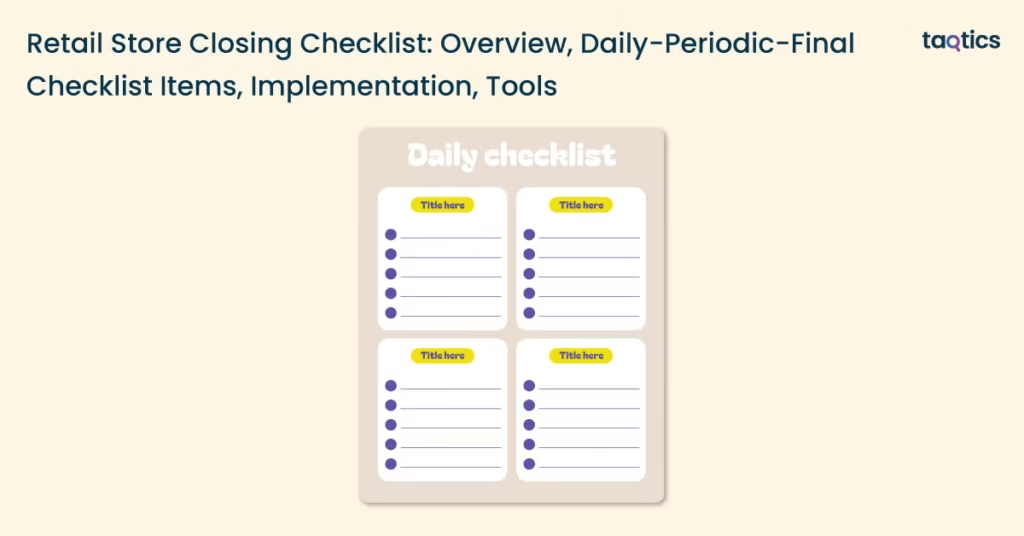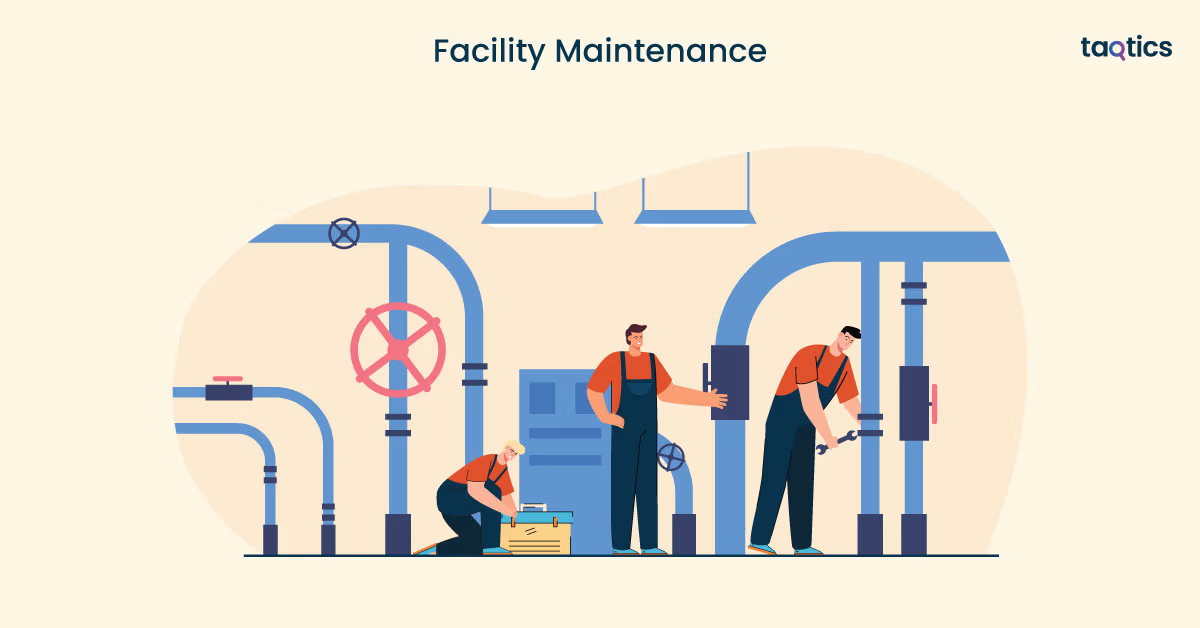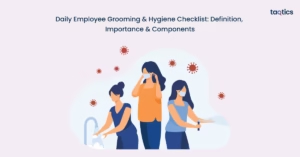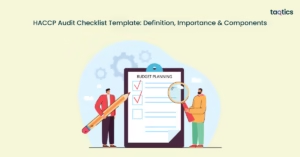Retail Store Closing Checklist: Overview, Daily-Periodic-Final Checklist Items, Implementation, Tools

A retail store closing checklist outlines critical tasks such as cash reconciliation, inventory management, cleaning, and securing the premises, which collectively minimize errors, prevent theft, and prepare the store for the next business day or final shutdown. A retail store closing checklist typically includes daily tasks like counting cash, cleaning, restocking, and locking up; periodic tasks such as deep cleaning and inventory audits; and final closure steps involving employee notifications and contract cancellations.
Effective implementation involves customizing the checklist to the store’s unique operations, training staff, assigning clear responsibilities, and using digital tools like Manifestly or eAuditor for real-time monitoring and compliance. For example, a clothing store’s daily closing checklist might include cash reconciliation, documenting inventory issues, tidying the sales floor, securing doors, and activating alarms before staff clock out.
By adopting a structured closing checklist supported by continuous improvement and digital tools, retailers can safeguard assets, streamline operations, and maintain high standards of customer service even as the store closes for the day or permanently
What is a Retail Store Closing Checklist?
A retail store closing checklist is a standardized, detailed procedure list designed to guide retail staff through all necessary tasks involved in closing a store, whether at the end of each business day or during a final store shutdown. A retail store closing checklist ensures that critical activities, such as cash reconciliation, inventory management, cleaning, security measures, and documentation, are completed consistently and thoroughly to maintain operational integrity, safeguard assets, and prepare the store for the next day or permanent closure.
By following a standardized checklist, retailers reduce the risk of errors, theft, and operational disruptions, while ensuring compliance with company policies and legal requirements. The checklist typically covers front-end tasks like counting cash drawers and securing confidential information, backroom duties such as restocking and organizing inventory, and security protocols including locking doors and activating alarms. This structured approach transforms the closing process from a routine task into a reliable, repeatable system that supports store efficiency and safety.
Why a Store Closing Checklist is Critical for Retailers?
A store closing checklist is critical for retailers because it systematically reduces operational risks and ensures consistent, secure, and efficient end-of-day or final closure processes.
- Prevents Inventory Errors: Without a standardized checklist, staff may overlook inventory checks, leading to discrepancies between recorded and actual stock. Administrative errors like these can result in substantial financial losses and disrupt supply chains5.
- Reduces Theft and Shrinkage: End-of-day is a vulnerable period for theft, both internal and external. Failing to follow closing protocols—such as securing cash, locking doors, and activating alarms—can increase the risk of theft. Regular use of checklists and loss prevention audits helps identify vulnerabilities and reduce shrinkage, which is a significant issue in retail.
- Minimizes Staff Miscommunication: Lack of clear procedures can cause confusion over responsibilities, resulting in missed or duplicated tasks. A checklist ensures all staff know their duties, improving communication and reducing the chance of errors or overlooked tasks.
- Keeps Retail Staff Accountable: Assigning checklist items to specific employees makes it easy to track task completion. If something is missed, management can pinpoint responsibility, promoting individual accountability and better performance.
- Improves Security and Safety: Consistent use of a checklist ensures all security protocols are followed, such as double-checking locks, setting alarms, and ensuring no one is left inside. This reduces the risk of break-ins, unauthorized access, and safety incidents.
- Enables Cost Savings: Routine tasks like turning off lights, adjusting thermostats, and shutting down electronics are often forgotten without a checklist, leading to unnecessary utility costs. Diligent adherence to these tasks saves money over time.
- Supports Consistency and Efficiency: Standardized checklists ensure that closing procedures are performed the same way every day, regardless of who is on duty, leading to predictable operations and a reliable customer experience.
Industry data shows that failing to train staff on opening and closing procedures leads to errors, inefficiencies, and increased security risks. Regular audits and procedural checklists are proven to reduce inventory discrepancies and theft, and improve overall store performance.
What are The Daily Store Closing Checklist?
The Daily Store Closing Checklist is a comprehensive protocol designed to secure the store, maintain accuracy, and ensure readiness for the next business day. Key items typically include announcing the store closing to customers, ensuring all customers have exited and the premises are clear, handling cash and registers by counting and reconciling cash, preparing deposits, and powering down systems.
Additionally, the checklist involves restocking and organizing merchandise, cleaning and maintaining the sales floor and facilities, executing security procedures such as locking doors and setting alarms, powering down equipment, managing staff by ensuring all employees clock out, and conducting a final walkthrough to verify completion and document any issues. This checklist ensures consistency, accountability, and security every night, providing a structured approach for closing staff to follow.
1. Front-End Closing Tasks
Front-end closing tasks are crucial for maintaining financial accuracy and security at the end of each business day. One of the most important responsibilities is counting cash drawers, which involves carefully reconciling the day’s sales with the cash on hand to ensure there are no discrepancies. After counting, staff must prepare bank deposits by organizing the cash and checks according to store policy and securing them in the safe or designated deposit bag.
Equally important is turning off all point-of-sale (POS) systems to prevent unauthorized access and potential data breaches. Staff should also ensure that all confidential information, such as transaction records and customer data, is properly secured, either locked away or stored in password-protected systems. By diligently completing these front-end closing tasks, retailers protect their assets, maintain accurate records, and uphold customer trust.
2. Back-End Closing Tasks
Back-end closing tasks are essential for ensuring the store is clean, secure, and ready for the next business day. These tasks begin with disposing of trash and recycling to maintain cleanliness and hygiene throughout the store. Setting alarms and surveillance systems is a critical security measure, protecting the premises after hours. Staff must also clear the store by ensuring all customers have left and checking areas like restrooms and fitting rooms.
Restocking shelves and displays prepares the store for the next day’s operations, while daily close housekeeping, such as sweeping, mopping, and tidying up, keeps the environment welcoming. Closing registers and POS systems is necessary to secure financial data and prevent unauthorized access. Locking up and performing final checks, including verifying that all doors and windows are secure, further enhances safety.
Effective employee communication ensures everyone is aware of their responsibilities and any important updates. Finally, daily checklist verification confirms that all closing tasks have been completed properly, promoting accountability and operational consistency.
What are the Periodic and Seasonal Store Closing Checklist?
Periodic and seasonal store closing checklists go beyond daily routines to ensure a retail business remains efficient, secure, and well-maintained during less frequent shutdowns, such as at the end of a season, fiscal period, or for extended holidays. Key periodic tasks include inventory management and facility maintenance.
Inventory Management
Effective inventory management in retail relies on several key practices, including cycle counts, seasonal markdowns, and inventory rotation. Regular cycle counts, including periodic checks of portions of inventory, help retailers maintain accurate stock records, quickly identify discrepancies, and reduce the risk of loss or theft; without these, retailers can lose 2% to 10% of their products annually due to shrinkage or miscounts.
Seasonal markdowns are another essential strategy, allowing retailers to optimize pricing and clear out seasonal merchandise at the right time to maximize revenue and minimize leftover inventory. By analyzing sales data and demand patterns, retailers can apply discounts strategically, balancing profitability with the need to move stock before it becomes obsolete or incurs carrying costs.
Inventory rotation, such as the first-in, first-out (FIFO) method, ensures older products are sold before newer ones, reducing waste and preventing expired or outdated goods from accumulating—this is especially critical for perishable or fast-moving items. Together, these practices help retailers maintain optimal stock levels, improve cash flow, and enhance the overall customer experience by ensuring popular products are available and fresh.
Facility Maintenance
Facility maintenance in retail stores involves a series of critical tasks that ensure a safe, efficient, and welcoming environment for both customers and staff. Regular replacement of HVAC filters is essential to maintain air quality and optimal system performance, as clogged or dirty filters can increase energy costs and reduce equipment lifespan.

Lighting maintenance, such as replacing burnt-out bulbs and checking backup lighting, is equally important for safety and customer experience, while periodic performance checks and upgrades to energy-efficient lighting can yield long-term cost savings. Deep cleaning routines, including window washing, carpet shampooing, and dusting high surfaces, help create a sanitary and visually appealing store, directly impacting customer satisfaction and reducing maintenance costs. Additionally, restocking backroom supplies like replacement bulbs, HVAC filters, and basic plumbing materials ensures that maintenance tasks can be addressed promptly without operational delays.
By following a structured maintenance schedule that covers these areas, retailers minimize downtime, prevent unexpected breakdowns, and maintain compliance with safety standards, ultimately supporting smooth store operations and a positive brand image.
What are the Final Shut Down Checklist?
The final shut down checklist for a retail store involves a series of critical steps to ensure a smooth and compliant closure, with two major focus areas: administrative closure and asset liquidation/property management.
Administrative Closure
Administrative closure is the process of formally winding down business operations and fulfilling all obligations to stakeholders. This includes notifying employees, customers, suppliers, and partners about the impending closure to maintain transparency and manage expectations. It also involves handling final employee payments, making sure all wages, bonuses, and accrued benefits are settled, and addressing the termination of employee benefits or providing assistance with unemployment information if applicable.
Proper documentation and record-keeping are essential during this phase to ensure legal compliance and to facilitate any future audits or reference needs. Clear communication and thorough administrative wrap-up help maintain goodwill and minimize the risk of disputes after the store has closed.
Asset Liquidation and Property Management
Once administrative tasks are complete, the focus shifts to asset liquidation and property management. This involves organizing the sale or auction of remaining inventory, store fixtures, and equipment to recover as much value as possible before closure.
Retailers must also address property-related obligations, such as terminating lease agreements in accordance with contractual terms and notifying landlords, as well as discontinuing utility services and settling outstanding bills. Managing these steps carefully ensures that the store’s physical assets are handled responsibly, financial liabilities are minimized, and the premises are vacated in compliance with legal requirements.
By following a detailed final shut down checklist, retailers can close their operations efficiently, protect their interests, and fulfill all necessary obligations.
How to Implement Retail Store Closing Checklist?
To implement a retail store closing checklist effectively, start by keeping checklists digital for easy accessibility and real-time updates. Digital checklists allow staff to access the most current procedures from any device and make it simple to update tasks as store policies or operations evolve, reducing paper costs and improving efficiency.
- Train all staff on checklist expectations through structured sessions and user-friendly guides, ensuring everyone understands their responsibilities and the importance of following each step.
- Regularly audit checklist compliance to maintain high standards, identify gaps, and reinforce accountability, this can be done through scheduled reviews and surprise checks.
- Utilize tools like Taqtics to automate and monitor task completion. Taqtics enables real-time tracking, photo uploads for task verification, and instant reporting, making it easier to ensure every closing duty is completed and documented properly.
By combining digital solutions, comprehensive training, routine audits, and automation tools, retailers can streamline store closing processes, minimize errors, and maintain operational excellence.
Which Tool Can Create Retail Store Closing Checklist?
Taqtics can create retail store closing checklist and be your best digital task management platform specifically for retail and restaurant operations. Taqtics enables you to create, schedule, and assign both ad-hoc and recurring checklists, ensuring that store teams always know what needs to be done and when. Its mobile checklists are accessible via web, Android, and iOS devices, making it easy for staff to complete tasks and update progress in real-time, whether they’re on the sales floor or in the back office.
Key features of Taqtics include automated task alerts and reminders, which help reduce missed steps and keep everyone on track. The platform also supports seamless team communication, allowing staff to report issues, share updates, and escalate problems directly through the app. Managers benefit from real-time insights, comprehensive dashboards, and the ability to export reports for audits or performance reviews.
With Taqtics, you can digitize your store closing procedures, automate compliance checks, and ensure operational consistency across all locations.
Ready to see how Taqtics can streamline your store closing process? Book a free demo or start your trial at Taqtics.co.
What are common mistakes in store closing procedures?
The common mistakes in store closing procedures are insuffieint training for employees, neglected safety protocols, poor cash handling, lack of communication, and skipped maintenance to name a few.
Insufficient Employee Training
Failing to properly train staff on closing procedures leads to errors, inefficiencies, and increased security risks. Staff may overlook critical steps or perform tasks incorrectly if they are not familiar with the closing checklist.
Neglecting Safety and Security Protocols
Overlooking safety measures—such as checking all exits, restrooms, and storage areas to ensure no one remains inside, and failing to activate alarm systems—can compromise store security and employee safety.
Inconsistent or Missing Procedures
The absence of a standardized, written closing checklist can result in important steps being missed, such as securing sensitive documents or locking all doors and windows.
Poor Cash Handling and Reconciliation
Not counting cash drawers accurately, failing to reconcile cash with sales records, or neglecting to prepare bank deposits can lead to discrepancies, theft, or financial losses.
Ignoring Inventory Checks
Failing to check and document inventory issues, such as missing, damaged, or low-stock items, can result in stock discrepancies and missed sales opportunities.
Lack of Communication and Task Delegation
Unclear communication about who is responsible for each closing task can lead to tasks being duplicated or overlooked, causing operational inefficiencies1.
Not Securing Sensitive Information
Leaving confidential documents, cash, or POS systems unsecured overnight increases the risk of data breaches or theft.
Skipping Maintenance and Cleanliness
Neglecting to tidy up the store, restock shelves, or perform basic maintenance can create hazards and negatively affect the store’s appearance for the next day.
Failure to Ensure All Employees Have Left Safely
Not confirming that all employees have clocked out and exited the premises can create security risks and liability issues.
Implementing a standardized, detailed closing checklist and ensuring all staff are trained and accountable can significantly reduce these common mistakes, improving security, efficiency, and store readiness for the next business day.
How to improve accountability during store shutdown?
To improve accountability during store shut down, businesses can adopt some fool-proof strategies.
Implement a Detailed Closing Checklist
Use a comprehensive, written checklist that covers all closing duties, such as cash reconciliation, inventory checks, cleaning, security measures, and equipment shutdown. This ensures every task is clearly defined and nothing is overlooked. Digital platforms like Manifestly or eAuditor can help standardize and automate these checklists, making them accessible and trackable for all staff.
Assign Specific Roles and Responsibilities
Allocate individual tasks to specific team members rather than leaving responsibilities vague. Assigning duties ensures each employee knows exactly what they are accountable for, making it easier to trace any missed or incomplete tasks. Digital tools can record who completed each task, further enhancing transparency.
Use Real-Time Monitoring and Reporting Tools
Leverage software that tracks checklist completion in real time. Managers can monitor progress, identify missed steps, and address non-compliance immediately. Reporting features also allow for trend analysis and identification of recurring issues, which can inform future training.
Conduct Final Walkthroughs and Verifications
Have a supervisor or manager conduct a final walkthrough using the checklist to verify all tasks are completed before leaving. This double-check process catches any missed steps and reinforces accountability.
Regular Training and Communication
Train all staff on the importance of closing procedures and how to use checklists effectively. Regularly review procedures, provide feedback, and update training materials as needed to keep everyone aligned and informed.
Continuous Improvement Through Feedback
Solicit feedback from employees about the closing process and update checklists based on their input and any operational changes. This keeps the process relevant and encourages staff buy-in.
Document Issues and Incidents
Require staff to document any problems or unusual events during closing. Assign follow-up actions to the appropriate team members, ensuring that issues are addressed and not repeated.
These practices ensure every task is completed, traced, and continuously optimized for operational excellence.



